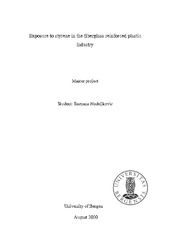Exposure to styrene in the fiberglass reinforced plastic industry
Master thesis
Permanent lenke
https://hdl.handle.net/1956/24096Utgivelsesdato
2020-09-22Metadata
Vis full innførselSamlinger
- Master theses [138]
Sammendrag
OBJECTIVE: To characterize exposure to airborne styrene and acetone among workers in the fiberglass reinforced plastic (FRP) industry. METHODS: Two full shift exposure measurements of airborne styrene and acetone were performed on 37 workers in two FRP companies (n=72). Urine samples were collected for the same workers pre- and post-shift on the first day for analysis of markers of exposure to styrene; Mandelic acid (MA) and phenylglyoxylic acid (PGA). Styrene and acetone concentrations were determinated by gas chromatography-mass spectrometry (GC-MS). Urinary MA+PGA was assayed by liquid chromatography with tandem mass spectrometry (LC-MS/MS). RESULTS: The overall arithmetic mean (AM) value of exposure to styrene for all production workers in the two companies was 11.8 ppm, which is below the Norwegian Occupational Exposure Limit (OEL; 25 ppm). The overall AM mean exposure to acetone among the same group of workers in the two companies was 69.7 ppm, which is below the OEL for acetone (125 ppm). There was a statistically significant, but weak correlation between exposure to acetone and styrene (r=0.375, p=0.001, n=72). The overall AM value for the post-shift MA+PGA for the production workers was 116,8 mg/g creatinine, which is below the Biological Exposure Index (400 mg/g creatinine) from the American Conference of Governmental Industrial Hygienists (ACGIH). The correlation between exposure to styrene and post-shift MA+PGA was strong and statistically significant (r=0.844, p<0.001, n=34). CONCLUSION: The exposure to airborne styrene and acetone is relatively high compared to the occupational exposure levels. Furthermore, for some of the workers post-shift urinary concentrations of the styrene metabolites MA+PGA were above the BEI.
